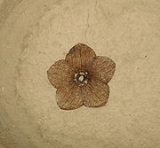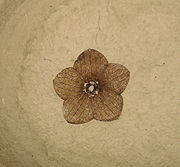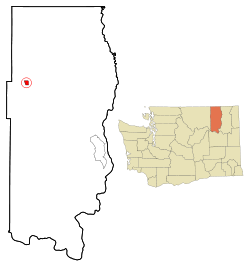
Stonerose Interpretive Center and Fossil Site
Encyclopedia


Fossil
Fossils are the preserved remains or traces of animals , plants, and other organisms from the remote past...
site and accompanying interpretive center, located in Republic, Washington
Republic, Washington
Republic is a city in Ferry County, Washington, United States. The population was 1,073 at the 2010 census, a 12.5% increase over the 2000 Census. It is the county seat of Ferry County.-History:...
, part of the Okanagan Highland
Okanagan Highland
The Okanagan Highland is a plateau-like hilly area in British Columbia, Canada, and the U.S. state of Washington . It lies between the Okanagan Valley on its west and the Kettle River on its east, and geologically is more or less an extension of the Thompson Plateau, which lies west of the Okanagan...
. The fossils are from organisms that lived in the area nearly 50 million years ago when the area that is now the city of Republic was part of an ancient lake. The old lake's bottom layers are now volcanic ash
Volcanic ash
Volcanic ash consists of small tephra, which are bits of pulverized rock and glass created by volcanic eruptions, less than in diameter. There are three mechanisms of volcanic ash formation: gas release under decompression causing magmatic eruptions; thermal contraction from chilling on contact...
hardened into sedimentary rock
Sedimentary rock
Sedimentary rock are types of rock that are formed by the deposition of material at the Earth's surface and within bodies of water. Sedimentation is the collective name for processes that cause mineral and/or organic particles to settle and accumulate or minerals to precipitate from a solution....
, becoming fine-grained tuffaceous shale
Shale
Shale is a fine-grained, clastic sedimentary rock composed of mud that is a mix of flakes of clay minerals and tiny fragments of other minerals, especially quartz and calcite. The ratio of clay to other minerals is variable. Shale is characterized by breaks along thin laminae or parallel layering...
. The fossils include various, and some extinct, insects, fish, leaves and twigs, as well as bird feathers. The Republic upland lacustrine
Lacustrine plain
Some lakes get filled up by the sediments brought down by the rivers and turn into plains in the course of time. Such plains are called lacustrine plains...
fossil beds are significant as they represent the earliest known records of the Rosaceae
Rosaceae
Rosaceae are a medium-sized family of flowering plants, including about 2830 species in 95 genera. The name is derived from the type genus Rosa. Among the largest genera are Alchemilla , Sorbus , Crataegus , Cotoneaster , and Rubus...
(rose family) and Aceraceae
Sapindaceae
Sapindaceae, also known as the soapberry family, is a family of flowering plants in the order Sapindales. There are about 140-150 genera with 1400-2000 species, including maple, horse chestnut and lychee....
(maple family).
The Boot Hill Fossil Site, located along Knob Hill Road, Ferry County, was first discovered in 1977 by artist Wesley Wehr
Wesley C. Wehr
Wesley Conrad Wehr was an American paleontologist and artist best known for his studies of Tertiary fossil floras in western North America, the Stonerose Interpretive Center, and as a part of the Northwest School of art.-Early life:...
and paleontologist Kirk R. Johnson. Since then, more than 200 species have been found in fossilized form. The fossil site is a short walk away from the interpretive center. Public digging is permitted with a permit. Visitors may retain up to three fossil pieces per person per day, though significant finds must be left at the site.
The fossilized Florissantia quilchenensis
Florissantia
Florissantia is a fossil flowering plant of western North America known from compression fossils from the Eocene to Oligocene found in several localities, including fossil beds in British Columbia, Washington State, Oregon, and Colorado. The plant is known from fossils of its flowers, fruits, and...
, a flower from an extinct cocoa
Chocolate
Chocolate is a raw or processed food produced from the seed of the tropical Theobroma cacao tree. Cacao has been cultivated for at least three millennia in Mexico, Central and South America. Its earliest documented use is around 1100 BC...
tree and a member of the Malvaceae
Malvaceae
Malvaceae, or the mallow family, is a family of flowering plants containing over 200 genera with close to 2,300 species. Judd & al. Well known members of this family include okra, jute and cacao...
family, is Stonerose's logo. Found by Lisa Barksdale, former Stonerose curator, and Wehr, at the time a paleobotanist and Burke Museum curator, it was featured in the National Geographic Magazine
National Geographic Magazine
National Geographic, formerly the National Geographic Magazine, is the official journal of the National Geographic Society. It published its first issue in 1888, just nine months after the Society itself was founded...
, July 2002. The fossil collections at the interpretive center holds a number of published fossil specimens, such as several rare Dillhoffia cachensis
Dillhoffia
Dillhoffia is an extinct monotypic genus of flowering plant with a single species, Dillhoffia cachensis known from Ypresian age Eocene fossils found in British Columbia, Canada, and Washington, USA...
fruits.
Both the interpretive center and the fossil site are owned and operated by the Friends of Stonerose Fossils, a non-profit organization.

